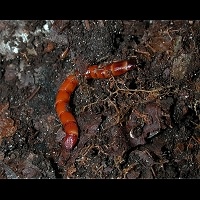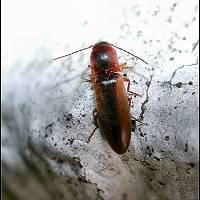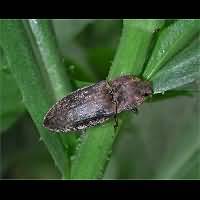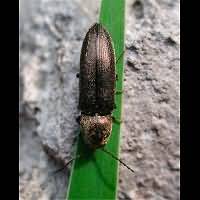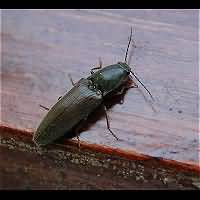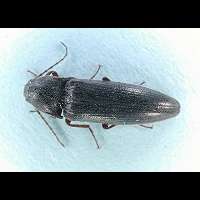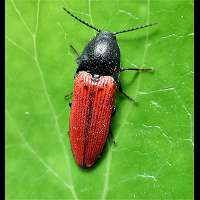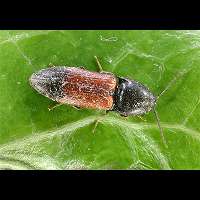[All pictures of garden wildlife on this page are thumbnails. Click on any thumbnail for a large format to be displayed.]
When beetles land flat on their back, it is very difficult for most of them to get back on their feet. May Bugs often die that way. Some beetles however do have a special hinch between belly and breast. It sends them quite high into the air, allowing them to turn around before getting back on earth. As they do this with a clicking sound, they are called Click Beetles. The larvae of the so-called Click Beetles are called wireworms. They can be harmful to grassroots and newly planted seedlings in places that used to be grassy. As they often appear in great numbers gardeners hate them alltogether. Even though most wireworms are vegetarians, the wireworm of the adult to the right do hunt for other insects as well. It is not certain the wireworm and the adult shown below belong to the same species. It is a common species all over Europe, even though it is not a typical garden species, for it lives in pine woods mainly. It is a rather small click beetle, measuring some 6 to 8 mm only.
To the left: the larvae of Click Beetles are called Wireworms. To the right: a click beetle from pine woods: Dalopius marginatus.
Most click beetles are rather dull, being brownish, greyish or blackish. The one to the left for instance is called the "mousegrey click beetle" in Dutch. Another frequent visitor of gardens is the black, slightly shiny Cidnopus aeruginosus. It can be distinguished from other black click beetles by the short hairs. In the right light they softly gleam yellowish, like gold. This click beetle has a groove in the thorax where the first elements of the antenna can be put for better protection.
To the left: a typical Click Beetle, Agrypnus murinus, common on the European continent. To the right: Cidnopus aeruginosus.
The adult click beetle, called Athous haemorrhoidalis, below to the left apparently has to do without an English common name. It is widespread, in continental Europe and on the British isles and its wireworm can be damaging in potatoes. However the larva eats rotting wood usually. Below to the right one of the many black species. Black click beetles are very hard to identify. The way the hair grows and the direction they grow in is often crucial. So taking their picture will usually not do the trick, unless you make a good close up, showing the hairs clearly. In this way the species here has been identified as being Melanotus rufipes.
To the left Athous haemorrhoidalis, a wide spread Click Beetle. To the right one of the many black species: Melanotus rufipes.
Luckily not all click beetles are dull looking animals. The ones below for instance are examples of the more exotic click beetles. The one below to the left has beautiful red shield. Unfortunately though, there are several similar species within the genus. It probably is Ampedus quercicola, for that is the commonest of these species. We could be wrong though. Reaching some 9 to 11 mm this is a typical woodland species. The larvae live in dead and decaying wood. It is common all over Europe, including both the UK and Ireland. Below to the right a similar species, except that the last one third of the shields is black. That's why we know this is Ampedus balteatus. It is about the same size as the species above (7 to 10 mm) and is active during the day. Regularly found on tree trunks and flowers. The larvae live in rotting wood for about three years. This too is a very common species all over Europe. We regret that the animal in the picture is rather dirty.
To the left: one of the very similar black and red Ampedus species, probably the very common Ampedus quercicola. To the right the also very common Ampedus balteatus.


© Copyright 1998-2024 gardensafari.net (Hania Berdys)

 English / engels
English / engels  Dutch / nederlands
Dutch / nederlands